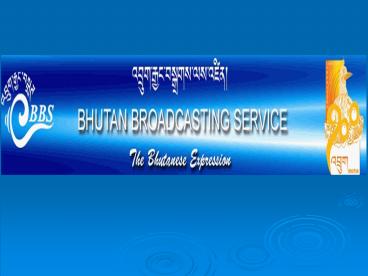Business Impact Analysis 2.2.4 - PowerPoint PPT Presentation
1 / 19
Title: Business Impact Analysis 2.2.4
1
(No Transcript)
2
Prime Minister Lyonchhen leaving to NY
3
Peach Melba for Dessert
4
Ministry Agr. and UNDP
5
(No Transcript)
6
Community Based Poverty Reduction
Initiative2008-2012
Royal Government of Bhutan
7
Objectives
- Bring poor households above subsistence level by
ensuring appreciable level of income. - Ensure social mobilization and collective
decision making in the execution of economic
activities. - Strengthen capacity of poor households through
skill up-gradation training to ensure
sustainability of employment activities beyond
project period.
8
Project Overview
- Scope 5 eastern districts (these are the 5
poorest) - Duration Oct 1, 2008 - Sept 30, 2012
- Budget US 500,000
- Stakeholders Ministry of Agriculture
- UNDP
- Government registered CSOs
- Representatives from the communities
9
Project Management
10
Strategy
- Identification of the CSOs
- Signature of individual contract between the
districts, UNDP and the selected CSOs - Facilitation of social mobilization by CSOs
- Particular focus on women and other disadvantaged
groups identified - Empowerment and capacity building of the
beneficiaries - Consolidation of the local farmers organizations
11
Roles Responsibilities (Govt UNDP)
- Government Identify CSOs with
appropriate capability. A government officer
will oversee activities of the CSOs.
Facilitate interaction and consultation with
departments, districts CSOs. Through its
designated agency either at National or District
level monitor progress - through reviews, visits and
participation in mtgs.UNDP Provide financial
resources Technical assist. to CSOs in
implementation of work plans (prepared by CSOs in
- collaboration with Govt).
- With Govt and CSOs, support
identification of options for HD initiatives at
district - level and identification of
research/training needs for beneficiaries.
Participate in review meetings and monitoring
visits
12
Why CSO
- Challenge reaching the genuine poor
- Social mobilisation and development is not a
spontaneous process. - Can play a critical role, as facilitator, in
- Social mobilization
- Organising them into clusters for development
intervention - training and capacity building
- Liaising with community to ensure sustainability
13
Roles Responsibilities (CSOs)
- Draw up annual work plan
- Liaise with community
- Provision of orientation capacity building
training - Identify location-specific feasible activities
- Help beneficiaries prepare their economic
proposal - Appraisal of proposal, funding and monitoring
- Develop standard of product (product dev, design,
packaging etc.) - Ensure collaboration with market and networking
- Find out sustainable ways and means
14
Deliverables of CSOs
- Survey and identification of feasible economic
activities - Social mobilisation and formation of farmers
group - 1/3rd must be of exclusively women farmers group
- Awareness built on possible income generating
ventures - Farmers provided with assistance for investment
activities - Training needs assessment through participatory
mechanism - Collaboration with research and institutes for
training - Quality of products for better marketing improved
- Marketing network established, marketing linkage
facilitated
15
ME
- Monitoring
- Annual Reports by Project Manager presented to
Project Board - Participatory process include beneficiaries
reporting on results - Evaluation
- Mid-term evaluation external, realign project
as necessary - Final external, for lessons learnt for future
interventions - Baseline
- and of unemployed members in the
employable age (15 65) - and of unemployed women in this age group
- Average house hold incomes.
- Results of initial survey of happiness using
Bhutan methodology - Indicators of success
- Annual incremental increases of 10 in all of
the above indicators - Overall 40 increase over the project duration
- Annual increase of 10 on level of happiness
16
Risk Management
17
Exit Strategy
- Exit
- Gradual exit of the program. Last year of the
strategy will be only supervising and advising
specific problem for the group. - Sustainability
- Social and cultural - the micro-enterprise was
identified in a participatory manner by the
community members themselves.. - Economic.- through continued improvement of the
product and search for marketing networks. - Capital micro-savings and micro-insurance
programme. - Political through, the participation of the
government from the initial stages including
through monitoring the progress of the
implementation.
18
Gross National Happiness
Indicatorseducationhealthemploymenttime
usecultural vitalityenvironmental
diversityemotional well beingliving
standardgovernance
19
HUMAN DEVELOPMENT WASHING POWDER































